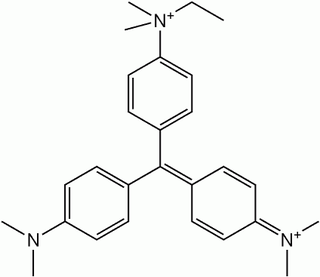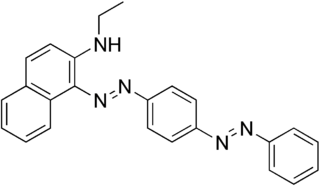
Salicylic acid is an organic compound with the formula HOC6H4COOH. A colorless (or, white), bitter-tasting solid, it is a precursor to and a metabolite of aspirin (acetylsalicylic acid). It is a plant hormone, and has been listed by the EPA Toxic Substances Control Act (TSCA) Chemical Substance Inventory as an experimental teratogen. The name is from Latin salix for willow tree, from which it was initially identified and derived. It is an ingredient in some anti-acne products. Salts and esters of salicylic acid are known as salicylates.

Rubbing alcohol is either an isopropyl alcohol or an ethanol-based liquid, with isopropyl alcohol products being the most widely available. The comparable British Pharmacopoeia (BP) is surgical spirit. Rubbing alcohol is denatured and undrinkable even if it is ethanol-based, due to the bitterants added.

Ethyl acetate is the organic compound with the formula CH3CO2CH2CH3, simplified to C4H8O2. This colorless liquid has a characteristic sweet smell and is used in glues, nail polish removers, and in the decaffeination process of tea and coffee. Ethyl acetate is the ester of ethanol and acetic acid; it is manufactured on a large scale for use as a solvent.

The dye Ethyl Green (C.I. 42590; C27H35BrClN3) is a triarylmethane dye. It is soluble in water.
Zirconium propionate is an ill-defined compound containing propionate and zirconium(IV). It is not soluble in water, but dissolves in isopropanol, ethanol and ethyl acetate. When tamped or untamped, it has a density of 1.14 g/cm3 or 0.98 g/cm3 respectively. It is used to promote adhesion in solvent-based inks.

Propiolic acid is the organic compound with the formula HC2CO2H. It is the simplest acetylenic carboxylic acid. It is a colourless liquid that crystallises to give silky crystals. Near its boiling point, it decomposes.
Enanthic acid, also called heptanoic acid, is an organic compound composed of a seven-carbon chain terminating in a carboxylic acid functional group. It is a colorless oily liquid with an unpleasant, rancid odor. It contributes to the odor of some rancid oils. It is slightly soluble in water, but very soluble in ethanol and ether. Salts and esters of enanthic acid are called enanthates or heptanoates.

p-Anisic acid, also known as 4-methoxybenzoic acid or draconic acid, is one of the isomers of anisic acid. The term "anisic acid" often refers to this form specifically. It is a white crystalline solid which is insoluble in water, highly soluble in alcohols and soluble in ether, and ethyl acetate.

Sudan Red 7B, also known as Solvent Red 19, Ceres Red 7B, Fat Red 7B, Hexatype carmine B, Lacquer red V3B, Oil violet, Organol bordeaux B, Sudanrot 7B, Typogen carmine, and C.I. 26050, is a red diazo dye. Chemically it is N-ethyl-1-[[p-(phenylazo)phenyl]azo]-2-naphthalenamine. It is soluble in oils and insoluble in water.
Thallium(I) carbonate is the inorganic compound with the formula Tl2CO3. It is a white, water-soluble salt. It has no or very few commercial applications. It is produced by treatment of thallous hydroxide with CO2.

Triphenylphosphine oxide (often abbreviated TPPO) is the organophosphorus compound with the formula OP(C6H5)3, also written as Ph3PO or PPh3O (Ph = C6H5). This colourless crystalline compound is a common but potentially useful waste product in reactions involving triphenylphosphine. It is a popular reagent to induce the crystallizing of chemical compounds.

Ethyl chloroformate is an organic compound with the chemical formula ClCO2CH2CH3. It is the ethyl ester of chloroformic acid. It is a colorless, corrosive and highly toxic liquid. It is a reagent used in organic synthesis for the introduction of the ethyl carbamate protecting group and for the formation of carboxylic anhydrides.

Salicylate poisoning, also known as aspirin poisoning, is the acute or chronic poisoning with a salicylate such as aspirin. The classic symptoms are ringing in the ears, nausea, abdominal pain, and a fast breathing rate. Early on, these may be subtle, while larger doses may result in fever. Complications can include swelling of the brain or lungs, seizures, low blood sugar, or cardiac arrest.

l-Arginine ethyl ester or ethyl arginate is an alternative supplement form of the conditionally-essential amino acid arginine bound to an ethyl ester. Esters are organic compounds formed by esterification – the reaction of carboxylic acid and alcohols.

Ethyl chloroacetate is a chemical compound used primarily in the chemical industry. It is used as a solvent for organic synthesis and as an intermediate in the production of pesticides.

Isopropyl salicylate is the ester formed by the condensation of salicylic acid and isopropyl alcohol. It is a transparent liquid that is sparingly soluble in water. However, it is soluble in ethyl alcohol and ether.

Ytterbium(III) nitrate is an inorganic compound, a salt of ytterbium and nitric acid with the chemical formula Yb(NO3)3. The compound forms colorless crystals, dissolves in water, and also forms crystalline hydrates.

EA-1763, O-PPVX, V1 or propyl S-2-diisopropylaminoethylmethylphosphonothiolate, is a military-grade neurotoxic organophosphonate nerve agent related to VX. It is part of the V-series. The substitution of a proton for methyl makes its properties more similar to those of VX.
















